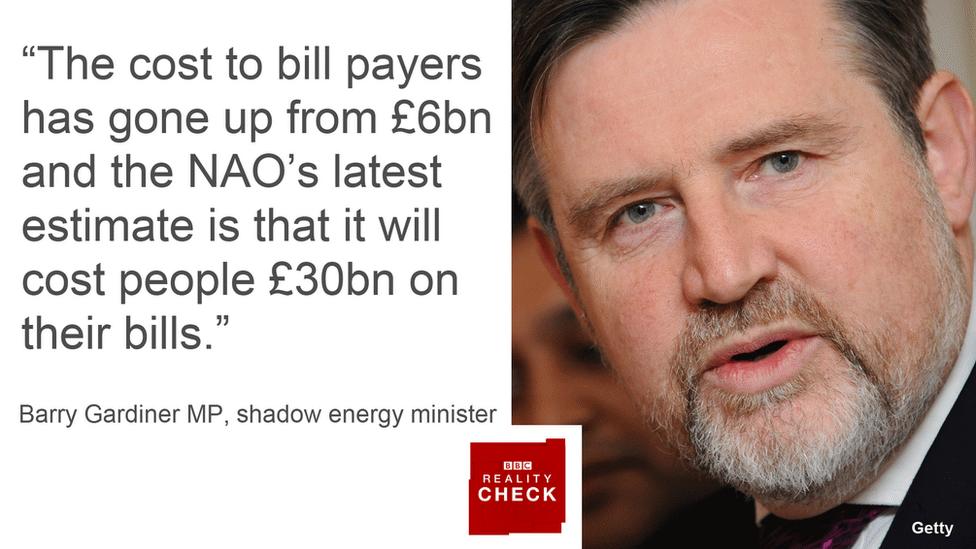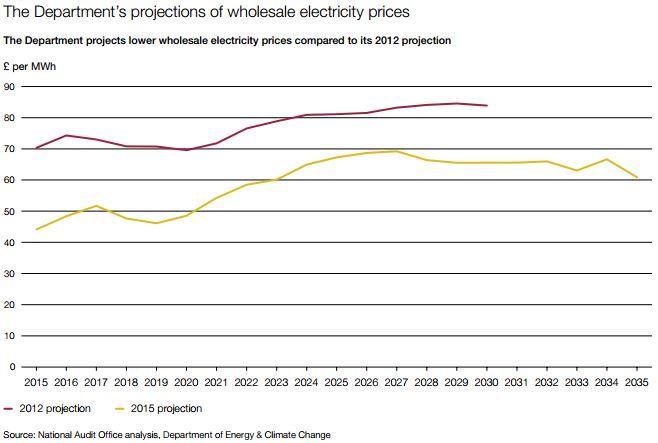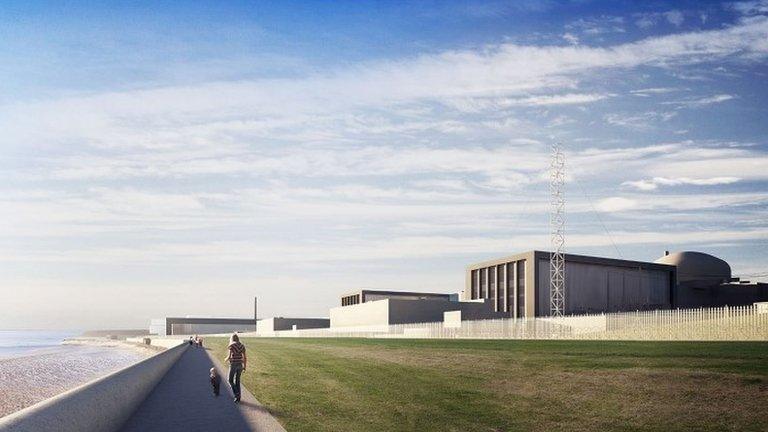Reality Check: How much would Hinkley C cost bill payers?
- Published

The claim: The cost of Hinkley Point C to bill payers has risen from £6bn to about £30bn.
Reality Check verdict: The projected additional cost of guaranteeing the amount paid for electricity from Hinkley C has risen considerably because the government forecast for the wholesale price of electricity has fallen.
The French state-owned power company EDF has agreed to shoulder the estimated £18bn cost of building Hinkley Point C, the first new nuclear power station in the UK for a generation.
The Chinese government will pay about a third with EDF paying the rest.
In return, the UK government has guaranteed EDF a fixed price for the electricity it produces for 35 years.
That fixed price, or strike price, is £92.50 per megawatt hour. One megawatt hour is enough electricity to run about 18,000 40in televisions for an hour.
In the UK, electricity is generated then sold to suppliers at a wholesale price. That electricity is then supplied to UK households and they pay for it through their electricity bills.
Energy companies charge us more than the wholesale price to cover their costs, various government charges, and make a profit.
The wholesale price moves up and down but the government has promised EDF it will get paid £92.50 per megawatt hour of electricity from Hinkley Point no matter what the wholesale price is. It will be £89.50 if another planned station, Sizewell C, comes online.
If the agreed strike price is above the wholesale price then consumers will have to pay higher bills to fund it.
The estimated extra amount they will pay has risen for one simple reason - the government's forecast for the wholesale energy price in the future has fallen. The lower the wholesale price, the bigger the chunk UK households have to pay to make sure EDF gets paid £92.50 per megawatt hour.
Oil and gas prices have fallen sharply since 2014 and the government has cut its wholesale price estimates as a result. Between 2012, when the strike price was agreed with EDF, and last year, wholesale price forecasts have been cut by more than a fifth.
The National Audit Office (NAO) said: "We estimate that the value of future top-up payments under the proposed HPC CfD have increased from £6.1bn in October 2013, when the strike price was agreed, to £29.7bn in March 2016."

The strike price of £92.50 is in 2012 pounds, so will be considerably higher by 2025. Already, if you adjusted for CPI inflation, the figure would be about £97.
Another figure that is given in 2012 pounds is the government's estimate that the cost of Hinkley C will add £10 per year to each household's bill. In current pounds that's about £10.50.
It's a figure that Andrea Leadsom gave to a parliamentary committee in May, external.
The government worked it out by predicting what the difference between the strike price and the wholesale price of electricity would be in 2025.
That difference was then multiplied by the amount of energy expected to be provided by the new plant and divided by the number of households.
The government predicts that in a central scenario, the wholesale price of electricity will rise from £48 per megawatt hour this year to £67 in 2025, all in 2015 prices. So the predicted difference between the strike price and the wholesale price is about £28 in 2015 prices.
Hinkley is supposed to produce 3,200MW - if you multiply by 8,760 you get the number of megawatt hours per year, which is about 28 million. Multiply that by the £28 difference between strike price and wholesale price and divide by the ONS projection of households in 2025, external (30 million) and you get £26 per household per year.
So where does the £10 per household actually come from? The government has so far declined to explain how this differs from its own calculation.
Last year, the government department responsible predicted that the project would add between £4bn and £19bn to household bills over the lifetime of the station (find the estimate by following the link in this parliamentary answer, external). If you take a central figure of £11.5bn, divide it by the projected 35-year lifetime and divide by the number of households, then you do indeed get to about £10 per household.
But the National Audit Office, external says that figure for project cost has risen to £29.7bn, and if you calculate that per household per year then you get to £25 per household per year.
It would make sense that if the overall cost has risen then the cost per household would also have gone up.
UPDATE 15 September
Many thanks to Simon Evans from Carbon Brief, external who got in touch to try to help us get closer to the government's figure.
He points out that power stations rarely run at full capacity - 90% would be a reasonable estimate over the course of a year, taking it from 28 million megawatt hours per year to about 25 million.
In addition, only about one-third of UK electricity is used by households, although some energy-intensive industries such as steelmaking will be exempted from paying the extra amount for their electricity.
Clearly, some of the extra electricity costs to businesses will be passed on to households through higher prices.
Simon Evans reckons the extra cost per household will be between £9 and £18 per year in 2012 pounds, depending on what the wholesale energy price ends up being, which puts the government's estimate at the low end.



- Published29 July 2016

- Published29 July 2016
- Published29 July 2016
- Published22 February 2016
